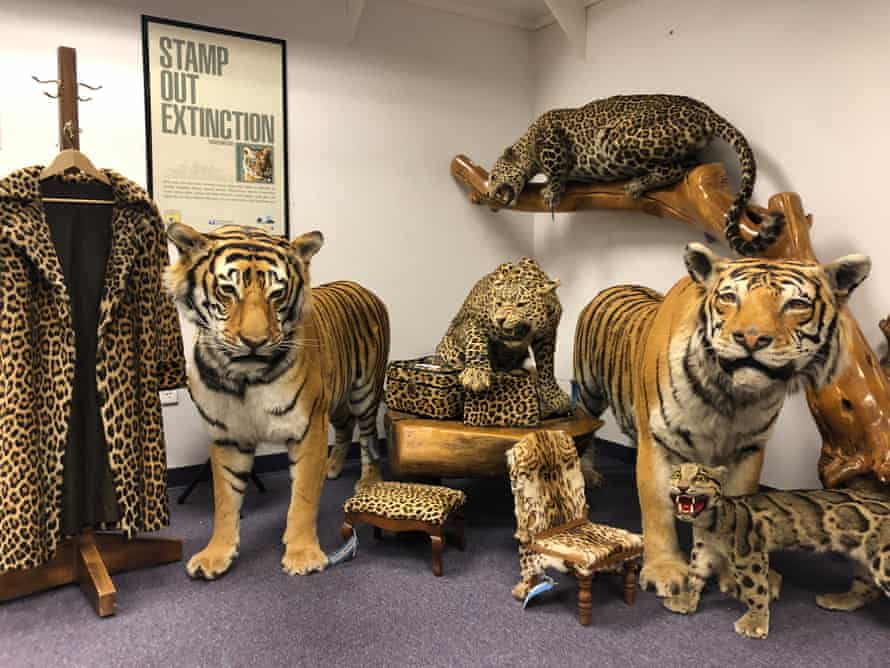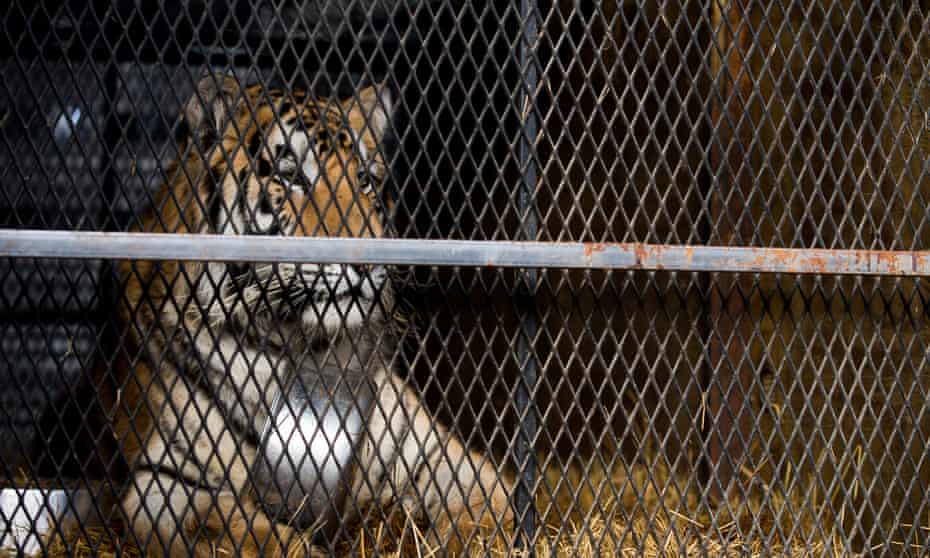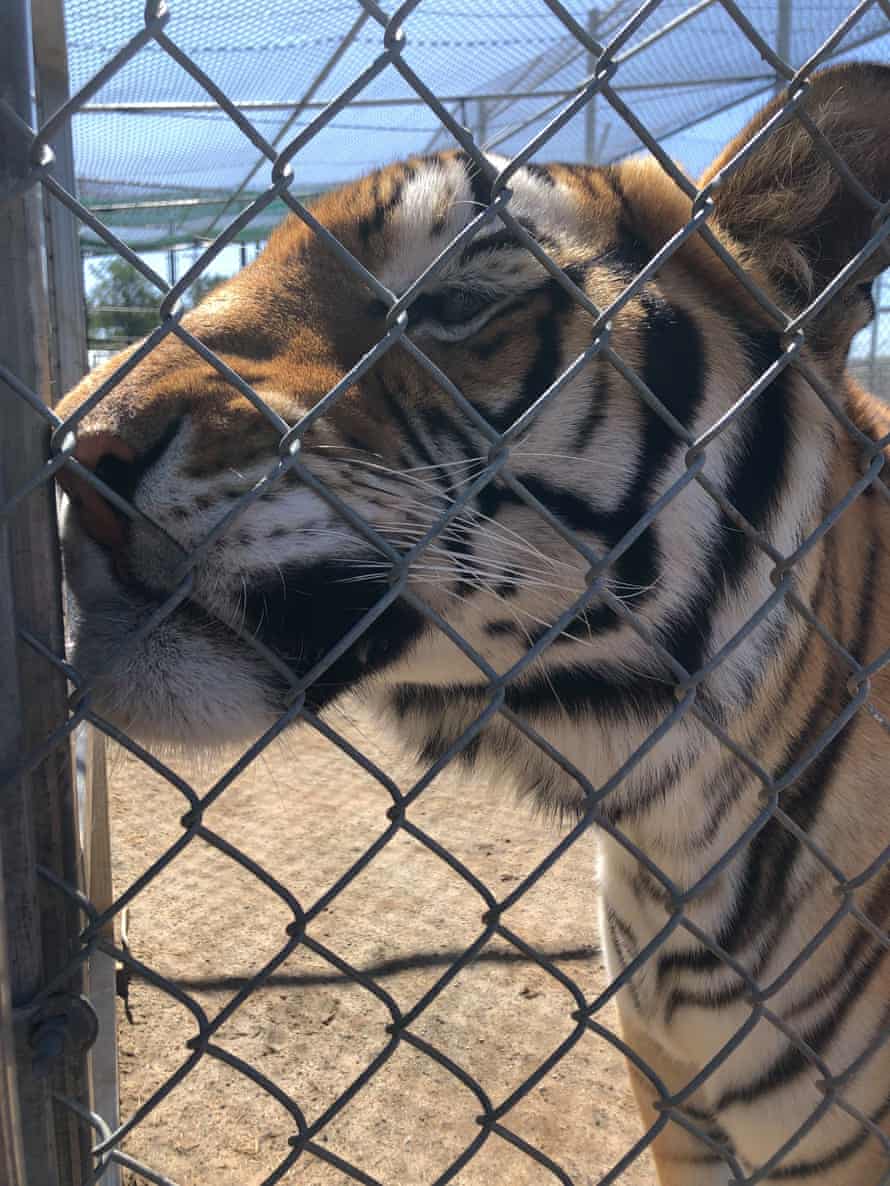[ad_1]
The primary pink flag was the shiny Chevy Camaro with no license plate.
“Something to declare?” requested the US Customs and Border Safety officer.
“Nothing,” replied the 18-year-old driver, Luis Eudoro Valencia, a local of the tiny desert city of Perris, California.
It was 1.30am on 23 August 2017, on the Otay Mesa port of entry, proper the place Mexico turns into California. The 24-hour crossing, one in all three linking Tijuana and San Diego, is the border’s busiest industrial level, filled with semis and flatbeds.
With such heavy cowl, possibly Valencia thought he might slip by.
A tagless Chevy most likely didn’t scream a lot past negligent driver – that’s, till an officer shone a flashlight on the person driving shotgun, 21-year-old Eriberto Paniagua, and an orange ball of fur darted between his legs.
“It’s only a cat,” Paniagua defined.
At six kilos, it could have weighed the identical as a tabby, however it didn’t seem like it. Minutes later, the officers had discovered a six-week-old Bengal tiger cub sitting within the entrance passenger footwell. A tiger.
Paniagua produced AeroMexico Cargo paperwork, even a gross sales receipt stating tigers aren’t a protected species (tigers are endangered and unlawful to import to the US and in any of the 175 nations that prohibit the worldwide commerce in threatened species).
Valencia claimed he simply wished an unique pet, after which shifted gears, admitting to having paid $300 to a Tijuana man he noticed strolling an grownup tiger on a leash.
The story shortly acquired weirder.
Scrolling his photograph roll and textual content messages, officers noticed it wasn’t a one-off: there have been pictures of monkeys, jaguars, lions. Valencia was a teenage wildlife trafficker.
The boys have been arrested and the Camaro impounded – however after the officers plopped the ball of fur right into a cardboard field, they put their heads collectively and questioned: what will we do with the cub?
‘So many large cats within the US disappear’

There are about 10,000 tigers within the US – extra in Texas alone than in India. Thirty states permit personal possession of predatory exotics like tigers. The necessities are deceptively easy: a USDA conservation label type and a $30 license. 9 states require no allow or license by any means. This enables nearly anybody to personal, breed and promote tigers.
Many of the commerce is grounded in a excessive demand for tiger bones and merchandise standard within the conventional Chinese language drugs market – which is how I find yourself in Colorado, stepping by the 22,000-square-foot Nationwide Wildlife Property Repository, a mausoleum of 1.3m confiscated animal merchandise.
Cabinets of mounted tigers, skins, medicinals, gold tooth earrings, claw necklaces, skulls unfold in entrance of me – the scene is eerily harking back to the ultimate scene from Raiders of the Misplaced Ark.
That is simply the tip of the iceberg, says Sarah Metzer, a US Fish and Wildlife Service training specialist. “What you’re seeing is possibly 10% of the entire seized items from US ports of entry.” She pushes apart a zebra pores and skin chaise longue to open a loading dock door. “There’s a lot contraband we’re operating out of area.”

Metzer heads a skeleton crew that catalogues, shops and loans objects to teachers and federal companies for coaching, even subject work. The tiger pores and skin in entrance of me could possibly be utilized in a sting operation. With solely 120 wildlife inspectors nationwide, USFWS leans closely on the border patrol and different regulation enforcement.
Passing a leopard coat, Metzer crouches by a moth-eaten Bengal tiger head and a snarling cub without end frozen by a taxidermist.
“This can be a tiger fetus somebody was making an attempt to promote on-line,” she says, sober as an undertaker. “If there’s cash to be made off of those animals, it doesn’t matter what type they’re in, there will likely be of us making an attempt to fulfill that demand.”
I ask if captive US tigers are smuggled abroad, and Metzer says there’s no approach wild tigers alone help this commerce. She leads me to an aisle housing hundreds of organ and bone medicinals – all tiger. “Each a part of the tiger is integrated in some kind of conventional drugs, and as a social standing image,” she says.
Scientific research present these merchandise comprise no medicinal properties. The Chinese language authorities admits as a lot, but permits the products so long as they’re from farmed animals.
“When you consider the monetary worth of the bones of grownup tigers, it’s enormous,” says John Goodrich, the chief scientist of Panthera, one of many main large cat NGOs. “That’s the reason for this enormous black market.”
With so lots of the animals within the US, is it then truthful to take a position that tigers from Texas find yourself as byproducts in Beijing?
“So many large cats within the US disappear,” says John R Platt, the editor of the Revelator, the media companion of the Heart for Organic Variety. “I’d not be shocked if US tigers have been turning up in China.”

Whereas listed as “endangered” underneath the federal Endangered Species Act, the regulation permits personal possession of captive-bred tigers so long as they’re used for “conservation”, however specialists say no tigers bred in captivity are ever launched. In 1900, there have been about 100,000 tigers within the wild. In the present day, about 4,000 stay in a handful of countries. If none return to the wild, how does personal possession of the feline profit the species?
“It doesn’t,” says Nicole Paquette, the Humane Society’s chief packages and coverage officer. “Public contact with large cats fuels each part of the commerce.”
That commerce contains every thing from Instagram-ready roadside zoos to six-figure tiger pores and skin rugs, in addition to tiger bone wines that run to tons of of {dollars} a bottle comprised of steeping a carcass in rice wine, then ageing it. Boiling, grinding and mixing bones with herbs kinds a glue-like plaster, all of which requires a gradual provide of components, which specialists say might be coming from farmed tigers in Asia and America.
Wildlife traffickers use the identical routes as narco traffickers, says Andrea Crosta, the pinnacle of Earth League Worldwide, an NGO utilizing counter-surveillance to struggle wildlife crime.
In South America, Crosta has documented poached jaguar tooth and bones shipped to China and handed off as tiger, one other corollary to the commerce affecting different species. “It’s straightforward to move, you simply put the fangs in your pocket and go on a aircraft. Jaguar canines in South America go for $200 to $300 – you may promote it in China as tiger for $5,000 to $10,000. You make actual cash.”
Border cub’s subsequent steps
Otay Mesa’s border cub now weighs greater than 300 kilos and will simply rip off your arm if you happen to tried to pet him. We meet within the mountains east of San Diego, close to Cleveland nationwide forest.
Lions, Tigers and Bears, the nonprofit that took the cub in, is purposely arduous to achieve, with dust roads and a ramification that resembles an Previous West model of Jurassic Park; I could make out the stalking silhouettes once I pull up.
Bobbi Brink, who began the sanctuary in 2002, greets me in a golf cart. I wedge beside her as we zoom by paddock after paddock – bobcats, pumas, leopards, bears, all victims of abuse and trafficking. The fences are excessive for a purpose.

We cease on the sprawling enclosure of the cub she baptized Moka, that means “likelihood” in Bengali. Life behind bars right here is as free as he might ever hope for.
Moka rises and stretches, muscle tissues rippling underneath brilliant orange fur. Farmed tigers are often better-fed and better-looking. Brighter coats drive up costs, that means that in an odd twist, wild tigers are value much less.
I can’t assist fascinated about the Netflix phenom Joe Unique. The Oklahoma zookeeper, dubbed the Tiger King, was convicted of a murder-for-hire plot in opposition to a Tampa animal sanctuary proprietor, falsifying wildlife information and violating the Endangered Species Act after he bought cubs to pay for the killing.
Leigh Henry, from the World Wildlife Federation, known as Tiger King a missed alternative. “I’d have hoped a present like that, with such a big viewership, would spotlight the problem of captive tigers within the US,” she stated. “We’ve been working for 15 years to attempt to get the US to clamp down, however every thing is up within the air due to Covid.”
A captive tiger lives about 20 years and prices $10,000 yearly for meals and care – which is why cubs are extra helpful. Grown up, they’re arduous to handle and fewer profitable. Adopters with good intentions however little coaching have no idea what they’re moving into once they fork over $500 for a cub. A child Moka can star on social media for an $80 photograph op at an ersatz zoo or petting venues that declare to breed tigers however in truth encourage trafficking.
“In case you cuddle or take a selfie with a tiger, you’re in a facility with no conservation worth and so they very effectively could possibly be promoting the physique components out the again door,” Debbie Banks, the tiger lead on the Environmental Investigation Company, tells me once I increase the problem a number of days after my go to to the sanctuary.
Dozens of lifeless tigers in freezers
Sketchy guidelines have one other worth: greater than 700 recorded large cat maulings and deaths within the US. In a single incident, referred to as the Zanesville Bloodbath, a mentally disturbed Ohio man freed 56 tigers, lions, bears and wolves earlier than killing himself. Police tracked and killed a lot of the animals, and Ohio has banned harmful exotics as pets.
In 2019, the Illinois consultant Mike Quigley launched the Large Cat Public Security Act, which might outlaw all large cat possession (the invoice has since been reintroduced within the Senate).
With out public information, numbers and areas stay unknown. “Not sufficient individuals discuss this,” says Quigley, whose workplace has discovered 77 services providing tiger cubs on the market. “There’s no central tiger database. And I’m not the one one asking ‘the place have all these large cats gone?’”
Killing these animals for revenue, promoting hides, components or meat are unlawful; and it’s unlawful to promote cats throughout state strains. But it may be authorized inside a state, primarily based on particular person regulation.
Take California. Of the 260 US Division of Agriculture-licensed exhibitors there, about 20 are accredited by the Affiliation of Zoos and Aquariums. With so many Hollywood trainers, theme parks, personal menageries, roadside zoos and pseudo-sanctuaries, California ranks third nationwide in harmful large cat incidents.
The market is big, however the penalties aren’t.
Cubs like Moka aren’t one-offs, says Phillip Land, a particular agent within the USFWS workplace of regulation enforcement on the southern border. “In Brownsville, Texas, they tried to smuggle a tiger cub in a trash bag throughout the border. They mainly dumped him on the facet of the river. Border patrol discovered it and known as us,” he says.
And in 2005, a breeder in Colton, California, was convicted of kid endangerment and animal cruelty after authorities discovered 11 tiger and leopard cubs in his attic, two tigers on the porch, 58 lifeless tiger cubs in a freezer, and about 30 lifeless tigers decomposing on the property.
The general public might think about these offenses comparatively insignificant, however Land tells me it’s usually the identical gangs at play as in different offenses. And with a lot cash, few laws and a wholesome pipeline, the issue isn’t going away.
The hunter-turned-conservationist Jim Corbett as soon as stated: “the e book of nature has no starting, because it has no finish.” A century later, with the species on the brink simply to make a medicinal wine that doesn’t even work, or to binge-watch a present earlier than all of us transfer on to the following hit, the haunting query stays: is that this the brand new regulation of the jungle?
[ad_2]
Source link








